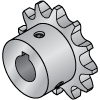(!) Since support from Microsoft will end on January 14th, 2020, Windows 7 will be excluded from the recommended environment from December 15th, 2019 on this site. Vì lý do Microsoft kết thúc hỗ trợ cho Windows 7 vào ngày 14/01/2020, Windows 7 sẽ là hệ điều hành không được khuyến khích sử dụng với trang web này từ ngày 15/12/2019.
Search by Category / Brand Tìm theo danh mục, nhãn hiệu
Search by Category Tìm theo danh mục
- Thể lệ và Giải thưởng cuộc thi "Thiết kế máy Tự động hóa 2025" do MISUMI Việt Nam tổ chức. Xem chi tiết.
- [Thông báo] Cập nhật địa chỉ kho tập kết hàng hóa tại khu vực miền Nam của MISUMI Việt Nam. Xem chi tiết.
[Announcement] Update on warehouse address in the Southern region of MISUIMI Vietnam. See more.
KYOUIKU GEAR MFG(KG) Sprockets
Brand |
|
|---|---|
| CAD |
|
| Days to Ship |
|
1 itemsMặt hàng
- Sort By
-
You can add up to 6 items per a category to the compare list.

Sprocket for ladder chain SW48B
KYOUIKU GEAR MFG(KG)
[Features]· Sprocket for rubber chain SWP (hard steel wire) with pitch of 4.8 mm.· Made from C3604B (free-cutting brass bar). Lineup of models with between 10 and 30 teeth available.
Sprocket Shape Nominal Number Number of Teeth(T) Shaft Bore Dia. d(mm) Number of Strands Material Chain Type Type Shaft Type Surface Treatment Roller Type Shape B - 10 ~ 15 4 ~ 6 1 C3604B (Free-Cutting Brass Bar) Others Pilot Hole Type Others Not Provided - From: 173,556 VND Days to Ship: Số ngày giao hàng: 4 Day(s) or more  4 Day(s) or more
4 Day(s) or more
| BrandNhãn hiệu |
|---|
| Product SeriesDòng sản phẩm |
| From |
| Days to ShipSố ngày giao hàng |
| Sprocket Shape |
| Nominal Number |
| Number of Teeth(T) |
| Shaft Bore Dia. d(mm) |
| Number of Strands |
| Material |
| Chain Type |
| Type |
| Shaft Type |
| Surface Treatment |
| Roller Type |
You can add up to 6 items per a category to the compare list. | |
| BrandNhãn hiệu | KYOUIKU GEAR MFG(KG) |
| Product SeriesDòng sản phẩm | |
| From | 173,556 VND- |
| Days to ShipSố ngày giao hàng | 4 Day(s) or more |
| Sprocket Shape | Shape B |
| Nominal Number | - |
| Number of Teeth(T) | 10 ~ 15 |
| Shaft Bore Dia. d(mm) | 4 ~ 6 |
| Number of Strands | 1 |
| Material | C3604B (Free-Cutting Brass Bar) |
| Chain Type | Others |
| Type | Pilot Hole Type |
| Shaft Type | Others |
| Surface Treatment | Not Provided |
| Roller Type | - |
Loading...Tải…
ConfigureTạo
Specification/DimensionsĐặc điểm kỹ thuật / Kích thướcĐặc điểm kỹ thuật / Kích thước
-
Sprocket Shape
-
 Shape A
Shape A -
 Shape B
Shape B -
 Shape C
Shape C -
 Shape SD
Shape SD
-
-
Nominal Number
-
Number of Teeth(T)
-
Shaft Bore Dia. d(mm)
- 4
- 5
- 6
- 7
- 8
- 9
- 9.53
- 10
- 10K
- 11
- 12
- 12.7
- 13
- 14
- 15
- 16
- 17
- 18
- 19
- 20
- 21
- 22
- 23
- 24
- 25
- 26
- 27
- 28
- 29
- 30
- 31
- 32
- 33
- 34
- 35
- 36
- 37
- 38
- 39
- 40
- 41
- 42
- 43
- 44
- 45
- 46
- 47
- 48
- 49
- 50
- 51
- 52
- 53
- 54
- 55
- 56
- 57
- 58
- 59
- 60
- 61
- 62
- 63
- 64
- 65
- 66
- 67
- 68
- 69
- 70
- 71
- 72
- 73
- 74
- 75
- 76
- 77
- 78
- 79
- 80
- 81
- 82
- 83
- 84
- 85
- 86
- 87
- 88
- 89
- 90
- 91
- 92
- 93
- 94
- 95
- 96
- 97
- 98
- 99
- 100
- 101
- 102
- 103
- 104
- 105
- 106
- 107
- 108
- 109
- 110
- 111
- 112
- 113
- 114
- 115
- 116
- 117
- 118
- 119
- 120
- 121
- 122
- 123
- 124
- 125
- 126
- 127
- 128
- 129
- 130
- 131
- 132
- 133
- 134
- 135
- 136
- 137
- 138
- 139
- 140
- 141
- 142
- 143
- 144
- 145
- 146
- 147
- 148
- 149
- 150
- 151
- 152
- 153
- 154
- 155
-
Number of Strands
- 1
- 2
-
Material
- Steel
- Stainless Steel
- Engineering Plastic
- C3604B (Free-Cutting Brass Bar)
-
Chain Type
-
Type
- Pilot Hole Type
- Shaft Bore Machined Type
- Keyless Type
-
Shaft Type
-
Surface Treatment
-
Roller Type
Application example related to this categoryVí dụ ứng dụng liên quan đến danh mục này
Related Categories to SprocketsDanh mục liên quan đến Sprockets
FAQ Sprockets
- Question: What are sprockets and how are they used in mechanical systems?
- Answer: Chain sprockets are mechanical components used in combination with chains to enable drive forces to be transmitted via a chain. The sprocket teeth engage with the chain links to establish a connection between the sprocket and the chain. Sprockets are crucial elements in the design and mechanics of machines and systems, indispensable for the mechanical transmission of movement and force, for example, in chain conveyors, packaging machines, and printing presses.
- Question: Can you explain the different types of sprockets, such as A, B, and C types?
- Answer: Chain sprockets are categorized into four main types of sprockets as established by the American National Standards Institute (ANSI):
1. Type A sprockets have no hubs, consisting solely of the plate with teeth.
2. Type B sprockets have a hub on one side for heavy loads and larger systems.
3. Type C sprockets, which have hubs of equal thickness on both sides of the plate for heavy loads and larger systems.
4. Type C (Offset) sprockets, also referred to as Type D, have two unequal-sized hubs, forming an asymmetric sprocket The choice of sprocket type depends on the specific requirements of the machine or system, such as space constraints, load capacity, and desired performance characteristics. - Question: What materials are commonly used to manufacture sprockets, and why?
- Answer: Chain sprockets are commonly manufactured using various materials, each chosen for specific applications and performance characteristics. The most common materials for chain sprockets include:
1.Carbon Steel: Suitable for solid sprockets in non-corrosive environments. It offers good wear resistance and is cost-effective.
2.Stainless Steel: Used for solid sprockets in corrosive environments. It provides excellent corrosion resistance and durability, such as in vegetable processing.
3.Plastic (UHMW Polyethylene and Nylon): These materials are used for sprockets in food processing and other industries where cleanliness and low friction are important. UHMW Polyethylene can withstand continuous temperatures up to 180°F, while Nylon sprockets provide 2-3 times the strength of UHMW and can withstand higher temperatures - Question: How does the number of teeth on a sprocket affect its performance?
- Answer: The number of teeth on a chain sprocket significantly impacts its performance. More teeth result in higher torque but lower speed, while fewer teeth lead to higher speed but less torque, following gear ratio principles. This choice affects wear and durability, as fewer teeth concentrate load, potentially increasing wear, while more teeth distribute load, enhancing durability. Additionally, sprockets with more teeth often provide smoother motion, reducing noise and vibration. Spatial constraints within the system must also be considered. Overall, the number of teeth on a chain sprocket is critical, influencing torque, speed, wear, durability, smoothness of operation.
- Question: What should be considered when selecting a sprocket for a specific application?
- Answer: Factors to consider when selecting a chain sprocket:
1. Chain Size: Ensure compatibility with the chain's size, pitch, and width for proper engagement and wear prevention.
2. Number of Teeth: Determine the appropriate number of teeth to balance speed, torque, and efficiency, considering the input-output relationship.
3. Material: Choose the sprocket material based on environmental conditions, load capacity, temperature range, and chemical resistance. Options include carbon steel, stainless steel, and plastic.
4. Shaft Size: Ensure compatibility with shaft size and type.
5. Alignment: Properly align the sprocket with the chain and other system components to prevent premature wear and ensure optimal performance.
6. Lubrication: Use appropriate lubrication compatible with the sprocket material and environmental conditions to prevent wear and extend the life of the chain and sprocket. - Question: How does the material of a sprocket influence its strength and friction resistance?
- Answer: When selecting material for chain sprockets, several key factors must be considered:
1. Selection Criteria: Material choice based on environmental conditions, load capacity, temperature range, and chemical resistance.
2. Strength and Friction Resistance: Material choice significantly impacts these characteristics.
3. Hardening Process: Essential for enhancing wear resistance and shock load absorption in sprocket teeth.
4. Optimization: The right material and hardening process optimize strength and friction resistance for specific applications.












How can we improve?
How can we improve?
While we are not able to respond directly to comments submitted in this form, the information will be reviewed for future improvement.
Customer Privacy Policy
Thank you for your cooperation.
While we are not able to respond directly to comments submitted in this form, the information will be reviewed for future improvement.
Please use the inquiry form.
Customer Privacy Policy